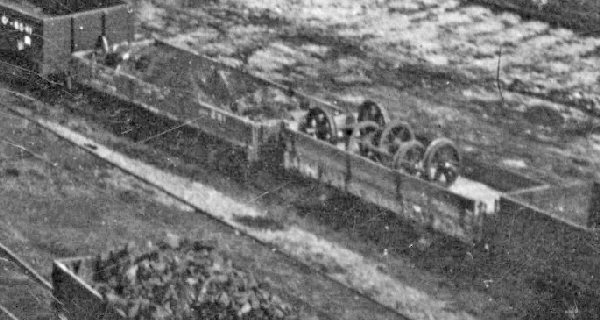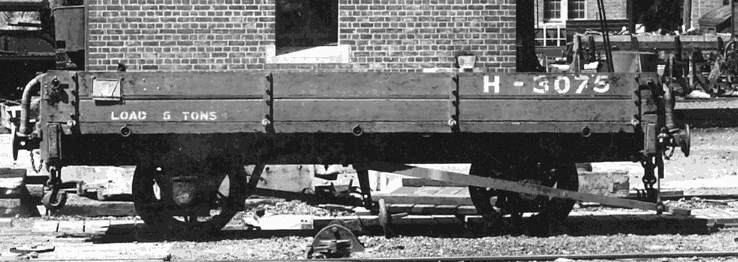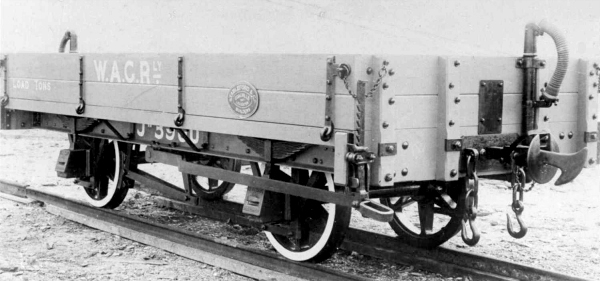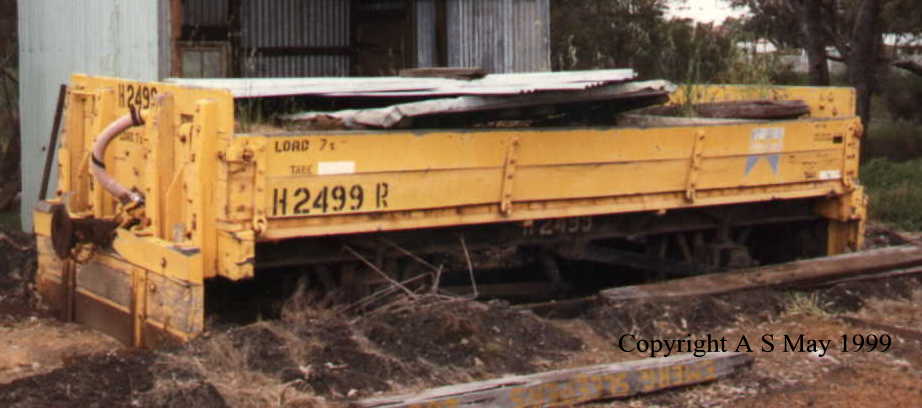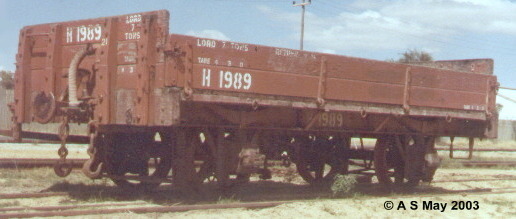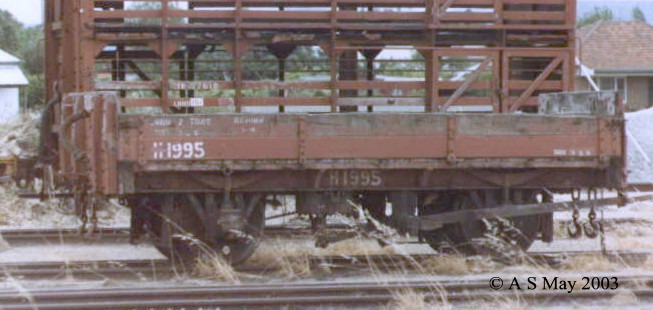| Class H low-sided wagons (classes J, JI, JW, P, V and T before 1900) |
|
This class is another of the early groups which incorporates wagons built to several different diagrams. It is also linked very closely with the early ballast wagons (the class K's were merely H's with drop doors in the floor). The shorter wagons built for the G.S.R. and MRWA have been successfully separated out on to their own pages. The early Northern Railway mineral wagons also have their own page. This leaves at least 9 types which I cannot, at the moment, fully separate. There was a significant amount of interchange with the Public Works Department (PWD) and contractors just to make things interesting. Colour coding is used to try and help. |
A blow up of an early postcard of Bunbury includes these two low-sided wagons. The left hand one can be identified as H281 but the nearer wagon is more of a mystery with no obvious markings. It is very narrow with the sides built directly above the solebars. It may be a very early Eastern or Northern Railway wagon, possibly ex contractor in restricted use around the Bunbury depot area. Some of Robb's wagons used in the Eastern Railway construction had sides directly above the solebars like this and so it could be one of the "P" class ballast wagons. (A S May collection) |
|
The types left covered by this page are: 1. The early low-sided wagons supplied by Metropolitan RCWCo. As originally drawn by MRCWCo these had 3 plank sides but all of the photos that I have seen show only 2 planks and they may have been assembled like this. These were class J or JW before 1900. They were on the same underframe as the JI class iron lined wagons. Other photos of these wagons in later life in the North West include Battye library photos 011255D and 000929D. The 1881 annual report show an intention to build 40 wagons of this type. 21 were in service by the following year (out of a total wagon stock of 38) increasing to 24 in 1883 (out of 47) and 26 in 1884 (out of 59). The following year this total dropped drastically to 14 (in 116 wagons) and at the same time 11 timber floats, 1 tanker and 26 mineral wagons appeared some of which were obviously conversions. The tanker was most likely F90 which was almost certainly a conversion from this group of low-sided wagons given that its number falls in the middle of a series of low-sided wagons. The Timber floats are not so easy to identify but are likely to have included numbers 13-16 (4) and 60-63 (4) and 111-122 (12) and some of these may be former low-sided wagons. By 1886 the total number of low-sided wagons had reached 18 and must have included those shown in the table below. A total of 27 low-sided wagons appeared in the 1888 report (possibly 192-200 added although 199 was a single bolster wagon by 1897). In 1889 the total was 38, a net increase of 11 which most likely corresponds to the numbers 209, etc. shown below. A second tanker appears in the 1886 report and this may be F98 which if true would, imply that the 1885 batch were numbers 96-104 inclusive. The low-sided wagons surviving in 1897 are known to have been numbered as in the table below although the construction dates are educated guesses. Clearly this is not yet a satisfactory story. |
| 1885? | 86-89, 91, (5 but 6 if F90 included) |
| 1886? | 96, 97, 99-104 (8 but 9 if F98 included) |
| 1888 | 192-198, 200, (A total of 8 but adding wagon 199 would make 9) |
| 1889 | 209, 211-216, 218, 219, 222 (A total of 11) |
| 1891 | 272-281 These may have been JI but the photo above suggests not. |
|
These wagons are all believed to have gone by the time that the wagon record cards started in 1909. The first two lines of the next table show known fates. New construction wagons which took these early numbers follow: |
| 1900 |
91, 103 missing from list. 209 likely replaced 195 became H4905, 244 became H4906 |
| 1903 | 274, 275 known to have been transferred to Jetty stock in 1903 |
| 1904 | D 86, 87, C195 built |
| 1907 | B 88, 89, 91, 96,97, 99-104 built |
| 1908 | GC 192-194, 196-200 , 211-216, 218, 219, 222, 272-281 built |
|
H209 ran until 1937. It is very unlikely to have been the original wagon by 1937 and I think it almost certain that the original wagon was replaced by a new H wagon in 1900-1901 (Type 8 below). The WAGR outline diagram of the Metropolitan RWCo supplied wagons is shown below.
| |
|
2. The 10 iron lined wagons built in 1891. Their numbers could be mixed up with the wooden wagons above or the ex NZR wagons below. These were class JI before 1900. They were 15'-0" long over headstocks. There is no trace of these wagons in the 1900 renumbering list so they may have been rebuilt to conventional low-sided wagons or other types by then. At present I do not know which numbers these wagons were but there is both documentary and photographic evidence that they existed. Battye library photo 007127 D shows the end of what is probably a Iron JI to the left. It still has the original couplers whilst the wagon to the right (probably an ex NZR T class) has chopper couplers. Thus the photo probably dates to c1892. |
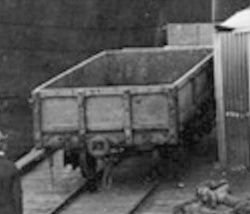 |
| 1907 | BB 1, 5 and D6, 7, 8, 10, 11 |
| 1908 | GC4901, 4902, 4917 |
|
4. Unfortunately the MRCWCo wagons and the ballast wagons don't appear to be the only early type of lowside. Drawings showing other early wagons include four old wagons on a 14'-1" underframe which were gone by June 1902. The diagram may refer to the remaining Northern railway wagons. There are other early wagons whose configuration is uncertain. The 1900 register includes wagons numbered 21, 34, 42, 4894, 4904, 4910 which all went before 1908 and are likely to have been old in 1900 and of uncertain type. The WAGR outline diagram is shown below.
5. The New Zealand Railways M class wagons imported from 1891-1896. These wagons were 2 planks high with a composite 15'-0" underframe. These became WAGR class T and were the forerunners of all of the NZR type wagons to run in WA. The couplings were changed on other all W.A.G.R. rolling stock to match this type which were the first wagons in WA to use the Norwegian "chopper" type coupling after a demonstration to the Minister of the superiority of the chopper type. These wagons were indistinguishable from the later standard H class except for the original NZR type axleboxes. |
| Ex NZR M class wagon H3075 photographed at Midland Workshops c1905. Note the non standard axleboxes. (WAGR official photo RHWA collection) |
|
The first purchase was of 100 NZR M class wagons in 1891 followed by a further 27 trucks in 1892. These are believed to be WAGR T283-398 and T529-533 (although this is a total of only 121 wagons it is possible other types were involved in the purchase). In 1896 another batch of NZR M class wagons were purchased from the NZR for £12000. These are likely to have been the wagons with WAGR numbers 3025-3174 (a total of 150). H3050 is confirmed as ex NZR. New Zealand Railways numbers were believed to be as follows (but note that this is a total of 152 wagons). |
| Greymouth district | 93, 108, 154, 286, 327, 334, 346, 371, 378, 380, 389, 401, 412, 428 (or 423?), 432, 438 (total 16) |
| Wellington district | 449, 519, 609, 651, 644, 812, 818, 892, 945, 990, 993, 995, 1065, 1249 (total 14) |
| Taranaki and Napier districts | 1096, 1119, 1121, 1128, 1130, 1132, 1135, 1142, 1155, 1156, 1157, 1167, 1183, 1186, 1194, 1197, 1207, 1210, 1212, 1220, 1321, 1328, 1333, 1334, 1318 (total 25) |
| Hurunui-Buluff district | 6, 20, 43, 61, 73, 84, 93, 94, 95, 97, 101, 116, 132, 135, 153, 160, 164, 166, 171, 195, 203, 205, 218, 231, 234, 246, 249, 261, 264, 268, 278, 279, 284, 290, 291, 318, 333, 414, 420, 426, 451, 457, 460, 481, 482, 483, 505, 508, 521, 541, 557, 566, 571, 580, 590, 614, 620, 682, 702, 721, 737, 770, 797, 799, 803, 810, 815, 819, 834, 835, 845, 849, 859, 883, 894, 907, 929, 930, 937 (Total 97) |
|
The State Library of WA photo (BA533/184) below shows two former NZR M class wagons imported from New Zealand. T~313 was one of the early imports and is in grey livery. JW 3081 is more interesting. It appears to be relatively newly painted and in a darker colour. I suspect it is still wearing its NZR Indian red. It also has its number at the right hand end as used after 1900 but has its pre 1900 class letters. It might be that it was importing these wagons that triggered the shift to Indian red after 1900.
The WAGR outline diagram is shown below.
The evidence given to the 1893 Royal Commission about the state of these wagons when received is confused, with the Locomotive Superintendent (W. Mather) being contradicted by the Engineer-in-Chief (C.Y. O'Connor paragraph 952). I am more inclined to believe O'Connor as Mather says both that they were in very bad condition when received but that he was happy to let them run. Both cannot be correct. |
|
6. The wagons built in Britain to the NZR design. This became the standard H class wagon on the W.A.G.R. These wagons were class J or JW before 1900. With the ex NZR wagons included there was originally a total of over 1100 wagons of the same type. They were built as follows: | ||
| Numbers | Builder | Batch size |
| W 895 -994 | Birmingham RCWCo. 1894 | 100 |
| V1018-1037 | 1895 | 20 |
| JW1202-1301 | Gloucester RCWCo 1895 | 100 |
| V1395-1436 | 1895 | 40 |
| JW1491-1540 | Oldbury CWCo 1895 | 50 |
| JW1935-1959 & 1985 | Oldbury CWCo 1895 | 26 |
| JW1927-1934 | Oldbury CWCo 1896 | 8 |
| JW1960-1984 | Oldbury CWCo 1896 | 20 |
| JW1986-2012 | Oldbury CWCo 1896 | 27 |
| JW2024-2063 | Oldbury CWCo 1897 (gap because of Northern Railway number series?) | 40 |
| JW2247 - ?? | Birmingham RCWCo. 1896 | 100? |
| ?? - 2446 | Oldbury CWCo 1896 | 100? |
| JW2747-2846 | Oldbury CWCo 1896 | 100 |
| JW3900-4070 | Stableford&Co 1897 | 71 |
| JW4071-4077 | Stableford&Co 1896 | 7 |
| JW4078-4149 | Stableford&Co 1897 | 72 |
|
One of the 1897 Stableford batch. I have not seen any in service photos showing the vacuum pipes sticking above the ends like this where they would be very prone to damage. (Photo RHWA collection) | ||
|
7. The ballast wagons known as Class V (later K class) were simply standard NZR type wagons with doors in the floor. However, once the K classification went out of use with the wagons either transferred to the PWD or sold, any remaining wagons of this type were either reclassified H or left unclassified. | 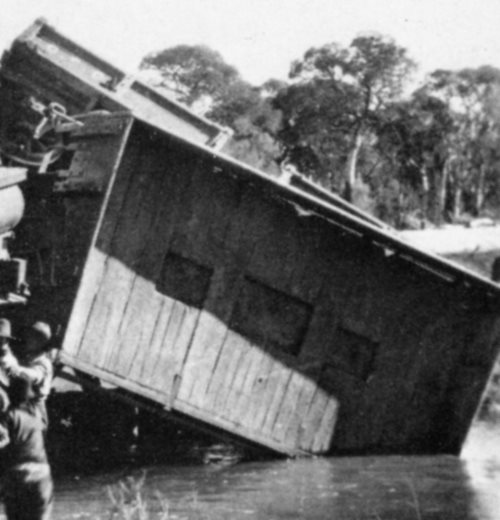 |
|
The photo at right shows a K class ballast wagon in an awkward predicament on the Waroona-Lake Clifton line, probably whilst in PWD ownership. The doors in the floor can clearly be seen. (Photo RHWA collection) |
|
8. The next group are 40 wagons built or rebuilt in 1900-03 with 3 plank sides to the same overall dimensions as the NZR type wagons. These are very difficult to identify in the list and may be rebuilds of existing NZR type H class wagons. The wagons listed in red numbers are possible candidates for this type. H4558 is believed to have been built in 1902. The WAGR outline diagram is shown below.
9. In addition there was the wooden framed vacuum braked version of type 6 which between 1904 and 1907 ran as class H but then became class HA . These are dealt with on their own page. 10. The final group are the ex contractors and PWD wagons. At this distance in time, unless photographic evidence comes to life it is almost impossible to tie down what type each individual wagon was. Some were definitely standard H class, some were likely to have been former K class ballast wagons, at least one was ex S.A.R. and some were probably early MRCWCo wagons. The best that I can do at the moment is to group them together and await further information. |
|
A very early picture of Midland Workshops with a G class open on the left and another mystery low-sided wagon on the right. It has fixed, very heavily braced, two plank sides directly above the solebars . It is clearly being used to transport rubbish from the workshops construction. Is it a Ballast wagon or a "Jetty stock" wagon? (Photo RHWA collection) |
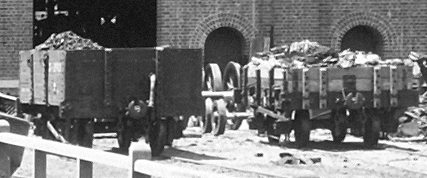 |
|
The following table records the known fates of the H class wagons. | |
| 200, 1429, 1952, 1971, 3069, 8800 fate unknown | |
| 1897 | 284-286, 288, 293, 296, 304, 305, 307, 317, 318, 322, 324, 326-329, 332, 333, 334, 336-340, 344, 345, 347, 375, 377-383, 387 listed as single bolster wagons (class L or M later class I) in 1897
331 missing 1897. 17, 21, 34, 42 Listed as lowside. 17 believed to be a standard NZR type wagon. |
| 1898 | 2037-2046, 2048-2062 to twin bolster wagons (class M later class N) |
| 1899 | 349, 2024, 2025, 2026, 2028, 2029, 2031, 2032, 2033, 2034, 2035, 2036, 3937, 3938, 3939, 3940, 3941, 3946, 3950, 3952, 3954, 3955, 3958, 3959, 3965, 3966, 3969, 3970, 3971, 3974, 3975, 3977, 3978, 3980, 3981, 3994, 3995, 3997, 4000, 4002, 4003, 4006, 4008, 4009, 4014, 4015, 4016, 4020, 4025, 4026, 4027, 4029, 4034, 4035, 4039, 4041, 4045, 4047, 4048, 4050, 4051, 4055, 4056, 4057, 4058, 4062, 4064, 4065, 4066, 4067, 4071, 4072, 4073, 4075, 4076, 4078, 4080, 4081, 4083, 4084, 4085, 4086, 4095, 4097, 4099, 4100, 4102, 4107, 4108, 4109, 4110, 4112, 4113, 4114, 4115, 4119, 4122, 4123, 4124, 4125, 4128, 4134, 4135, 4136, 4137, 4138, 4139, 4140, 4142, 4145, 4146, 4148, 4149 listed as water tankers (class F later class J) in 1899 |
| 1900 | 1019, 1021, 1031, 1395, 1397, 1403, 1406, 1408, 1413, 1416, 1418, 1419, 1420, 1422, 1425, 1426, 1427, 1432 listed as class H (rather than K) in 1900 reclassification.
4881, 4882, 4883, 4884, 4885, 4886, 4887, 4888, 4889, 4890, 4891, 5095, 5096, 5097, 5098, 5099, 5100, 5101, 5102, 5103 ex Smith & Timms (1, 3, 4, 16, 19, 21, 22, 23, 27, 29, 32, 2, 5, 7, 8, 24, 26, 28, 30, 37 respectively) Most of these seem to have been hoppers classified H in error. This was rectified in 1905 with only 4887 remaining as an H. 42, 297, 311, 341, 348, 369, 388,1938, 1943, 1957, 2063, 3025, 3049, 3074, 3079, 3088, 3089, 3126, 3132, 3149, 3166, 3168, 3921, 4892 listed as class G in 1900 103 , 343, 951, 1213, 1217, 1220, 1235, 1246, 1252, 1259, 1297, 1495, 1499, 1509, 1522, 1523, 1934, 1985, 1991, 2008, 2027, 2030, 2256, 2275, 2276, 2280, 2285, 2295, 2311, 2331, 2333, 2342, 2358, 2386, 2413, 2431, 2434, 2749, 2755, 2756, 2757, 2759, 2763, 2765, 2772, 2773, 2780, 2784, 2790, 2791, 2792, 2794, 2795, 2800, 2802, 2803, 2804, 2805, 2806, 2807, 2808, 2810, 2811, 2812, 2814, 2815, 2816, 2817, 2818, 2819, 2820, 2821, 2822, 2823, 2824, 2825, 2826, 2827, 2828, 2829, 2830, 2831, 2832, 2833, 2834, 2836, 2837, 2838, 2839, 2840, 2841, 2842, 2843, 2844, 2845, 2846, 3068, 3108, 3129, 3162, 3902, 3904, 3907, 3912, 3914, 3917, 3918, 3930, 3931, 3932, 3934, 3935, 3967, 3985, 3987, 3988, 3993, 4017, 4018, 4019, 4028, 4033, 4040, 4036, 4042, 4049, 4054, 4069, 4091, 4094, 4111, 4117, 4121, 4132, 4141, 4147 to class J in 1900 There was also a duplicate JW3987 which was renumbered H4899 H4919, 4920 were given to two wagons with no numbers listed as JW in 1900 - origins uncertain but both were eventually converted to G so may have been standard NZR type wagons which had lost their numbers. H4894, 4904, 4910, listed as JW in 1900 are likely to have been old wagons with missing numbers as these numbers were re-used for new GC class wagons in 1908. H4909 was either a standard wagon which had lost its number or a new Type 8 wagon. 91, 288, 295, 308, 317, 318, 320, 323, 325, 327, 328, 329, 335, 347, 353, 355, 372, 373, 375, 376, 398, 532, 533, 986, 1037, 1228, 1251, 1271, 1396, 1398, 1399, 1401, 1402, 1405, 1409, 1411, 1412, 1414, 1415, 1424, 1430, 1431, 1433, 1434, 1435 , 1501, 4022, 4032, 4037, 4043, 4046, 4053, 4059, 4068, 4074, 4079, 4089, 4096, 4098, 4105, 4106, 4120, 4126, 4131 all missing at 1900 renumbering possibly sold, transferred to PWD or scrapped. JW195 was renumbered to H4905 There were two wagons numbered 244. II244 became G244. JW244 was renumbered to H4906 JW366 became H4907. |
| 1901 | 1022, 1026, 1030, 1031, 1032, 1035 to class G |
| 1900-2 | 4558 built 1902
Possible other wagons of type 8 built at this time 209, 4356? 4570? |
| 1903 | 274, 275, 389, 396 , 1903, 1962, 1964, 1968 to Jetty stock (253, 249, 254, 246, 250, 259, 260 & 255 respectively)
3802 to class G |
| 1904 | 21, 86, 87, number re-used by new wagons (classes FA, D & D respectively)
1069, 1070 built as H but to new design with wooden GB type underframe. |
| 1905 | 141, 1063, 1064, 1075, 1077, 1891, 1894, 1897, 1898, 1899, 2079, 4248, 4249, 4253 built as class H but to a new, wider vacuum braked design with wooden GB type underframe.
141, 1063, 1064, 1069, 1070, 1075, 1077, 1891, 1894, 1897, 1898, 1899, 2079 4248, 4249, 4253 reclassified as HA. 4881, 4882, 4883, 4884, 4885, 4886, 4888, 4889, 4890, 4891, 5095, 5096, 5097, 5098, 5099, 5100, 5101, 5102, 5103 ex Smith & Timms wagons reclassified as L . |
| 1905/6 | 1018, two wagons numbered 1019, 1020, 1021, 1023, 1024, 1025, 1027, 1028, 1029, 1033, 1034, 1036, 1400, 1404, 1417, 1423, 1428, 1429 ex class K
1429 problematic.......... |
| 1907 | 3899 ex G by 1907
34 - number re-used by new D 88, 89, 90, 96, 97, 99, 100, 101, 102, 104 numbers re-used for new B class cattle wagons so these wagons must have gone before 1908. |
| 1908 | The numbers 192, 193, 194, 196, 197, 198, 211, 212, 213, 214, 215, 216, 218, 219, 222 , 272, 273, 276, 277, 278, 279, 280, 281 , 357, 358, 359, 360, 361, 362, 363, 364, 365, 366, 384, 385, 386, 390, 391, 392, 397, 1300, 1395, 1397, 1403, 1406, 1407, 1408, 1410, 1413, 1416, 1418, 1420, 1421, 1422, 1425, 1426, 1427, 1432, 1436, 1961, 1963, 1965, 1966, 1967, 2263, 3076 , 4887 , 4894, 4902, 4904, 4905, 4906, 4910, 4917 were all re-used for new GC class wagons so these wagons must have gone before 1908.
176 was re-used for a new GD |
|
Most of the preceding information comes from a very small number of sources and is incomplete. From 1909 the wagon record cards began and so we are on firmer ground from here on (although given the variety of types involved it's still fairly soggy). |
| 1909 | 298, 314, 346, 350, 352, 367, 370, 395 1239, 1249, 2360, 2391, 2777, 3031, 3033, 3034, 3045, 3055, 3057, 3061, 3072, 3077, 3078, 3082, 3085, 3086, 3090, 3091, 3092, 3094, 3095, 3096, 3101, 3120, 3131, 3139, 3144, 3151, 3152, 3155, 3163, 3169, 3170, 3172 , 4060, 4919, 4920 to class G by this stage
984, 3969, 3977, 3978, 3980, 3981, 3995, 4035, 4073, 4095 ex J by 1909 907, 1247, 1275, 1286, 1506, 1511, 1521, 1525, 1532, 1932, 1944, 1979, 2257, 2302, 2310, 2325, 2369, 2372, 2400, 2401, 2406, 2787, 3038, 3048, 3134,3143, 3158, 4007, 4012, 4030 listed as class J by 1909 294,2073 listed as class J by 1909 922, 1289, 1294, 1515, 2343, 2415 to class J 961, 1540, 2286, 2337, 2762, 4090 sold to Smith and Timms |
| 1910 | 1518, 1526, 2345, 2446 and 4103 transferred to Hopetoun where they stayed. |
| 1911 |
4011 to class G 531, 4138 sold to PWD Carnarvon |
| 1912 | 8787 - 8806 ex Smith & Timms at Port Hedland where these wagons remained. These almost certainly include the group of 6 wagons sold to Smith and Timms in 1909.
354 , 919, 942, 946, 1028, 1029 , 1927, 1946, 1949, 1990, 1994, 2308, 2317, 2323, 2327, 2362, 2384, 2389, 2416, 2751, 3056, 3083, 3117, 3137 , 3905, 3923, 3961, 4144 converted to class J. 1272 replaced by new GC built with this number. |
| 1913 | 145, 229, 232, 258, 421, 428 ex PWD Port Hedland. These may have included some early wagons. |
|
A group of 20 wagons which became H8787- 8806 were taken over from Smith and Timms in 1912 on completion of the Port Hedland Railway contract. These wagons remained at Port Hedland. The Port Hedland group certainly included at least one old wagon of the MRCWCo type, possibly ex PWD (see Battye Library 4689B/74a) as well as newer NZR type wagons. Another group of 13 wagons were taken over from the PWD in 1918 H10064-10071 and 1919 H10078-10082 . It is unclear where these had originally come from but they are most likely standard NZR type ex WAGR wagons although they didn't last long. At around this time the height of the ends of H class wagons was increased to 3 planks. At first this third plank was not the full width of the end of the wagon but by the 1950s most survivors seem to have had full 3 plank ends. The WAGR outline diagram showing the narrow top plank below. |
|
|
| 1917 | 3042, 3130 to class HA (may have been replaced by a new HA). |
| 1918 | H10064-10071 ex PWD (unclassified Ballast wagons at first - became class H in 1919) |
| 1919 | H10078-10082 ex PWD |
| 1920 | 931, 1020 , 2288, 3978 written off |
| 1923 | 479, 520, 1291, 1516, 2255, 2354, 2499, 2617, 2746, 2809, 2813, 2835, 3707, 3724, 3982, 4029, 4031, 4034, 4056, 4064, 4065, 4083 from class J |
| 1924 | 4087 ex class J |
| 1925 | 3059 ex class J |
| 1929 | 933, 10065 to Jetty Stock - numbers not known
10069 to Jetty Stock 353 3899 to class HA (may have been replaced by a new HA). |
| 1930 | 10064, 10066, 10067, 10068, 10070, 10071, 10081, 10082to JETTY stock 32, 33, 44, 45, 46, 47, 51, 52<
10078, 10079, 10080 written off |
|
In 1931 the WAGR took over 17 "low end wagons" from the PWD. PWD 8, 9 and 17 were not retained. 8 and 17 were noted as having "old design" wooden underframes. PWD 1 had a South Australian underframe. The rest had GC type wooden underframes. |
| 1931 | 4355, 4522 ex PWD 8 and 17 written off immediately - not repaired
4209 ex PWD 1 on South Australian type underframe. Ballast plough. 4518 ex PWD 13 Ballast plough with trapdoors in floor. 4225, 4266, 4290, 4295, 4343, 4353, 4515, 4516, 4517, 4519, 4520, 4521 ex PWD wagons (2-7, 10-12, 14-16) with trap doors for Ballast. |
| 1932 | 8821, 8822 ex J class at Port Hedland
258, 8789, 8791, 8796, 8799, 8804 to class J at Port Hedland 284 written off |
| 1934 | 258 from class J Port Hedland
229 to class J Port Hedland |
| 1935 | 319, 947, 1236, 1404 , 2012, 2279, 2316, 2398, 2754, 2835, 3100, 3113, 3122, 3125, 3963 to JETTY stock 315, 415, 317, 406, 308, 426, 316, 410, 429, 312, 416, 314, 414, 453, 430.
956, 974, 982, 1025, 1203, 1237, 1254, 1491, 1929, 1976, 2261, 2272, 2298, 2321, 2335, 2365, 2393, 2443, 2793, 3070, 3141, 3148, 3937, 3960, 4356 written off |
| 1936 | 368, 1518, 1526, 2271, 2345, 2396, 2446, 2799, 2801, 3908, 3951, 4038, 4103 sold to Harbour and Lights Dept Hopetoun.
1974, 2300 to JETTY stock 459 and 455. 943, 949, 2270, 2284, 2336, 3165, 4010, 4343 written off |
| 1937 | 209, 330, 378, 917, 939, 950, 971, 1024, 1278, 1423, 1519, 1520, 1928, 1939, 2356, 2410, 2432, 2753, 2760, 3032, 3084, 3157, 3161, 4137, 4519, 4521 to JETTY stock 496, 489, 510, 511, 497, 490, 512, 528, 498, 449, 513, 514, 529, 530, 501, 499, 491, 492, 531, 500, 502, 532, 515, 503, 533, 534, 493
2361 listed as both JETTY 408 and 499 1250, 2399, written off |
| 1939 | 558 ex D (N.Z.R. type) at Port Hedland.
1209, 1265, 1400, 1428, 1517, 2010, 2350, 2363, 2370, 2436, 2809, 3145, 4225 to JETTY 212, 242, 472, 473, 248, 323, 474, 234, 243, 249, 224, 42, 26 895, 959, 1229, 2368, 3027, written off |
| 1941 | 394, 910, 936, 966, 1958, 1999, 2283, 3099, 3140 , 4101 written off |
| 1942 | 903, 1034 , 1219, 1248, 1281, 1930, 1977, 2077, 2746, 3114, 3173 , 3927, 3948, 4092 written off
289, 952, 1023, 1954, 3916, to JETTY 596, 578, 137, 476, 497 |
| 1943 | 232 to class J |
| 1944 | 520, 988, 1202, 1280, 2264, 2414, 2417, 2440, 3043, 3105 written off
1301, 2778 to JETTY 43, 92 1023, 1025, 1034, 1047, 1052, 1054, 1080, 1083, 1097, 1101, 1120, 1137, 1143, 1145, 1150, 1151, 1158, 1163, 1203, 1219, 1237, 1248 written back. Original numbers unknown. 1023, 1034, 1219 and 1248 could have regained their old numbers as they were only written off in 1942. 1025 , 1203, 1237 are less likely to have been the original wagons as these were written off in 1935. Some of these reinstated wagons were ex Jetty stock. |
| 1945 | 306, 970, 1528, 1942, 2339, 4133 written off |
| 1946 | 428, 1284, 2408, 3159 written off
1257 to JETTY 160 |
| 1947 | 301, 1231, 1274, 1960, 2314, 2371, 4034, 4064, 4083 written off
8802 written off (Port Hedland?) 421, 8790, 8792, 8798, 8805, 8806 to JETTY 648, 168, 258, 214, 649, 128 |
| 1948 | 290, 2247 to JETTY stock 666 and 664
1137, 1299, 1955, 2319, 2378, 3037, 3097 written off |
| 1949 | 2796, 3996, 4130 to JETTY stock 20, 58, 749
984, 1248, 1417 , 1508, 1536, 1992, 1998, 2274, 2403, 2429, 2785, 3039, 3071, 3135, 3979, 4061, 4290 written off |
| 1950 | 371, 1221, 1226, 1986, 2002, 2788, 3121, 3986, 4062, 4087 to JETTY stock 795, 789, 796, 769, 797, 777, 798, 799, 800, 766
1295, 2761, 3103, 4063 to Albany Harbour Board 920, 923, 969, 1080, 1097, 1266, 2266, 2385, 2769, 3154 , 4008, 4021 written off |
|
In 1951 the Port Hedland line closed and the wagons there were transferred to the PWD. From 1952/3 construction of replacement low-sided wagons began with the HC and HD classes. Inevitably this lead to H class wagons being written off. During the early 1950's wagons 17, 1212, 2259, 2499, 3142, 3153, 3980, 4209, 4295 and 4518 were converted to ballast ploughs which are discussed on a separate page. They are also listed below on this page in Italics. |
Ballast plough H2499 at Narrogin in the early 1980's. (Photo A S May) |
| 1951 | 993, 1287, 1494, 2301, 2347, 2439, 2441, 2764, 2783, 2797 sold to PWD.
145, 258, 558, 914, 955, 992, 1019, 1232, 1282, 1502, 1516, 1533, 1534, 1537, 1997, 2006, 2248, 2297, 2309, 2322, 2357, 2390, 2422, 2774, 3041, 3900, 3990, 4000, 8787, 8788, 8793, 8794, 8795, 8797, 8801, 8803, 8821, 8822 to PWD Port Hedland 380, 979, 1158, 1230, 2315, 3933, 3991, 4056, 4520 written off 1025 to JETTY 425 |
| 1952 | 1973 to class N
326 , 1052, 1255, 1498, 1937, 2404, 4013 written off 1219, 2776 later written back |
| 1953 | 901, 1244, 2292, 2444, 2766, 3087 missing at stock take - presumed scrapped.
2430 to JETTY 201 924, 2420, 2433, 2747, 3075, 4209, 4353 written off 2776 written back |
| 1954 | 2269 to class HW
897, 967, 990, 1238, 1513, 2251, 2306, 2318, 3051, 3052, 3104 to class N 1150 to JETTY stock 913 1203, 1268, 1529, 1933, 2289, 2296, 2395, 2427, 3066, 3707, 3929, 4118, 4517 written off 1219 written back |
| 1955 | 305, 312, 927, 938, 989, 991, 1940, 1970, 2254, 2268, 2354, 2781, 3102, 3926, 3977, 4558 to N
1514 to JETTY stock 47 283, 300, 911, 962, 973, 976, 1018, 1033 , 1214, 1218, 1222, 1256, 1277, 1290, 1935, 1947, 1951, 1993, 2001, 2007, 2282, 2313, 2340, 2344, 2377, 2382, 2405, 2418, 2421, 2442, 2779, 3046, 3156, 3167 , 3956, 3999, 4065, 4146, 4515 written off 2420 written back |
| 1956 | 324, 4909 to JETTY stock 123 and 127
896, 968, 1054, 1083, 1224, 1276, 1291, 1292, 1419, 1505, 1538, 1984, 1987, 2287, 2332, 2359, 2375, 2392, 2409, 2412, 2775, 3036, 3160 , 3724, 3949, 4004, 4055, 4077, 4119, 4129, written off |
| 1957 | 2425 to class N
309, 913 to class NS 2004, 2776, 3128, 3913, 3955 to class HW 1034, 1264, written off |
| 1958 | 1208, 4108, 4516 written off |
| 1959 | 2278, 3050 to class NS
2273, 2617, 3164, 3943, 3976 written off |
| 1960 | 2758 to class NS
1969, 2005, 2281, 3059, 3138 written off 2348 to JETTY stock but listed as both 807 and 847! One of these was probably one of the other write offs above. |
| 1961 | 915, 1285, 2373, 2771, 3060, 3123, 3962 to class DW.
948, 1996, 2260 to class HW 941, 2394, 2786, 3035 to class NS 928, 1047, 2419, 4295, 4570, 4899 written off. |
| 1962 | 291, 1036, 2397, 3995 to class NS
292, 302 , 916, 945, 960, 1206, 1283, 1497, 1504, 1507, 1936, 2258, 2326, 2328, 2411, 3063, 3153, 3171 , 3911, 3925, 3928, 3998, 4029 written off |
| 1963 | 977, 2437 to HW
2767, 3053 to Ash wagons 529, 2290 to JETTY 181 and 179 |
| 1964 | 1145, 1945 to JETTY stock 241 and 252
1027, 1207, 1267, 2353, 3944 to ash wagons 2293 written off |
| 1965 | 310,1978 to JETTY stock 299 and 302.
315, 316, 957, 1151, 2262, 2388, 2752, 3029, 3116, 3972, 4907 written off |
| 1966 | 983, 1227, 1273, 3109, 3110 written off |
| 1967 | 1262, 1492, 2376, 3058, 4030 converted to class NS
303, 304 , 925, 1242, 1950, 2265, 2748, 3106, 3115 , 3947, 4001, 4002, 4005, 4031, 4082, 4135 written off |
| Surplus BE class cattle trucks were converted to class HCL in 1965-7. Although these had lighter springs than the standard HC they were capable of replacing the H class wagons on lighter loads and thus another cull in H class numbers began in 1968. |
| 1968 | 287, 299, 321, 333, 342, 898, 899, 902, 905, 921, 926, 932, 937, 954, 965, 972, 978, 1120, 1204, 1219, 1225, 1241, 1243, 1258, 1298, 1493, 1931, 1941, 1948, 1956, 1975, 2000, 2249, 2253, 2277, 2312, 2338, 2366, 2374, 2423, 2424, 2435, 2438, 2798, 2813, 3026, 3030, 3040, 3107, 3119, 3133, 3136, 3919, 3936, 4016, 4035, 4070, 4086 written off |
| 1969 | 2349, 3093 , 3901, 3915, 3924, 3953, 3981 converted to NS
315 written back |
| 1970 | 382 , 908, 918, 934, 935, 964, 981, 987, 1023 , 1205, 1211, 1270, 1496, 1503, 1535, 1972, 1988, 2047, 2299, 2355, 2380, 2381, 2387, 2402, 2768, 2770, 3047, 3073, 3080, 3112, 3147, 3174 , 3909, 3957, 3968, 3969, 3982, 3992, 4073, 4088, 4109, 4143 written off
1261 to NS |
| In 1971 the conversion of CXA class sheep trucks to HE class low-sided wagons meant a final batch of large scale withdrawals with the last few survivors hanging on until the 1980's on menial tasks.
H1989 and 1995 spent their final years at the livestock wagon cleaning shed at Midland. Neither of these two received yellow paint. |
H1989 at Midland in the early 80's. |
| 1971 | 1253, 1260, 3081 to JETTY stock 32, 34 and 4
296, 313, 900, 906, 953, 958, 963, 975, 1101, 1223, 1296, 1953, 2250, 2291, 2320, 2334, 2351, 2379, 2782, 3028, 3127, 3910, 3920, 3942, 3980 , 4023, 4024, 4095, 4142, 4149, 4266 written off |
| 1972 | 1216, 1269, 1531, 2009 to JETTY stock 44, 45, 43, 46
285, 315, 322, 351, 356, 374, 530, 904, 909, 912, 940, 985, 994, 1021 , 1143, 1163, 1210, 1234, 1240, 1245, 1263, 1279, 1288, 1293, 1500, 1510, 1512, 1527, 1530, 1539, 1959, 2003, 2011, 2267, 2303, 2305, 2307, 2329, 2330, 2341, 2346, 2352, 2428, 2445, 2750, 2789, 3062, 3064, 3065, 3067, 3098, 3118, 3124, 3146, 3903, 3983, 3984, 3989, 4006, 4044, 4051, 4052, 4076, 4104, 4116, 4518 written off |
| 1973 | 17, 479, 944, 3054, 3111, 3142 , 3150 , 3964, 4113, written off |
| 1974 | 980, 3044, 4093 written off
2426 converted to NS |
| 1975 | 1212, 2383, 3906 written off |
| 1976 | 930, 1524, 2294 written off |
| 1977 | 2252, 2255, 2304, 2324, 2364, 2367, 2407, 2420, 3922, 4127 written off |
| 1978 | 929, 1215, 3945 written off |
| 1979 | 1233, 1237, 1989, 1995, 2059, 2499 , 3973 written off
1237, 1989, 1995 written back |
| 1981 | 2499, 3973 written back |
| 1983 | 1237,1989 written off |
| 1995, 2499, 3973 last of class. No date is given for the write off of 2499 and 3973 but it was before 1995 went as the last of the class in 1994. |
|
|
| H1995 at Midland in the early 1980's. By this stage it had gained all of the modifications - higher ends, vacuum brakes, and disc wheels. It was also getting on for 90 years old. (Photo A S May) |
